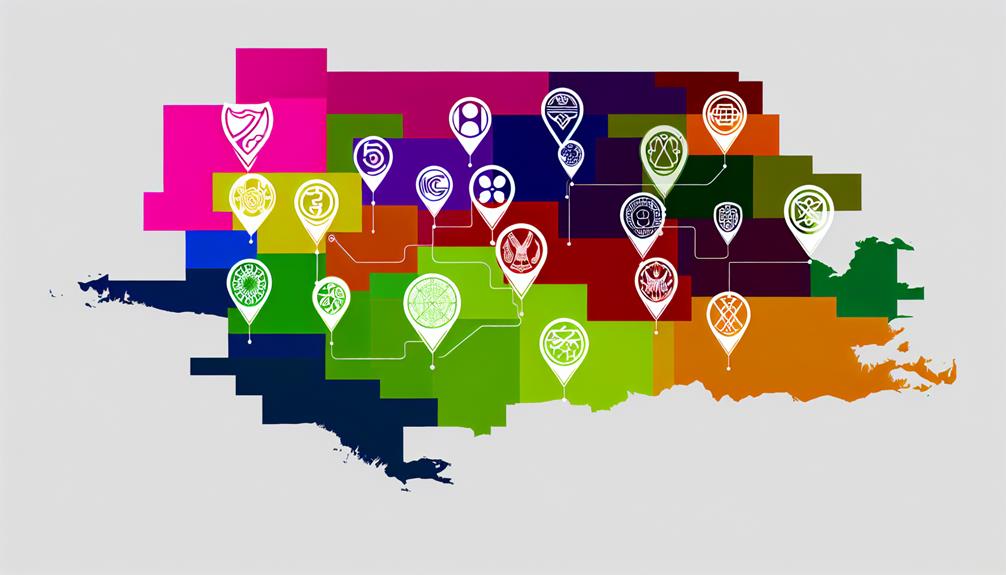In today's digital landscape, regional SEO techniques have emerged as pivotal for businesses aiming to capture the attention of targeted audiences. By honing in on specific regional keywords, companies can enhance their online presence and engage with local consumers more effectively. Crafting content that mirrors local customs and dialects not only elevates authenticity but also fosters a deeper connection with the community. Additionally, the strategic use of local landmarks and collaborations with area influencers can significantly boost credibility. As businesses seek to maximize engagement and conversion, one must consider the nuanced interplay of these elements. But what are the key strategies that lead to success?
Understanding Regional Keywords
Effectively understanding regional keywords is crucial for optimizing your content to meet the specific needs of a local audience. In the realm of regional SEO, these keywords are the foundation upon which successful localization strategies are built. By tailoring your keyword strategy to reflect the linguistic nuances, cultural references, and local vernaculars of a specific area, you can significantly enhance your content's relevance and visibility in local search results.
A comprehensive approach to regional keyword research involves analyzing search patterns within the targeted geographic location. This includes identifying the terms and phrases that local users employ when searching for products or services similar to yours. Utilizing tools like Google Keyword Planner or SEMrush can provide insights into the most frequently searched terms in a specific region, helping you to pinpoint high-traffic keywords that resonate with the local populace.
Moreover, understanding regional keywords extends beyond mere translation. It demands a deep cultural and contextual comprehension of the region. This involves recognizing colloquial expressions, slang, and local dialects that might influence search behaviors. For instance, a term popular in New York may not hold the same significance or search volume in Los Angeles. Therefore, regional keyword research should be meticulously tailored to reflect these differences.
Additionally, considering local events, holidays, and trends is vital for timely and relevant keyword selection. By aligning your content with these local elements, you not only enhance engagement but also foster a stronger connection with the audience.
Ultimately, mastering the art of regional keywords ensures your content remains pertinent and authoritative within the local search landscape.
Crafting Localized Content
Crafting localized content is a pivotal element in any regional SEO strategy, aiming to engage and resonate with the target audience on a personal level. This approach requires a deep understanding of the cultural, linguistic, and societal nuances unique to each region, ensuring that content not only attracts but also retains local interest.
A strategic focus on localized content involves tailoring messaging to reflect the specific preferences, values, and dialects of the target audience, thereby fostering a sense of relevance and connection.
To effectively craft localized content, businesses must begin by conducting thorough market research to identify the distinct characteristics and needs of their target audience. This entails analyzing local trends, cultural references, and consumer behavior patterns.
By integrating these insights into content creation, businesses can produce articles, blog posts, and multimedia content that genuinely reflect the local identity and resonate with the community.
Additionally, leveraging local language and dialect is crucial in making content more relatable. This does not merely involve translation but rather an adaptation of content that embraces regional vernacular and idiomatic expressions.
Engaging local writers or content creators familiar with the area can significantly enhance authenticity and relatability.
Further, localized content should incorporate specific local events, landmarks, or news that appeal directly to the community. By embedding these elements into digital content, businesses can increase their visibility and engagement within the region.
Moreover, collaborating with local influencers or community figures can amplify the reach and credibility of localized content, fostering trust and encouraging audience interaction.
Optimizing for Location-Based Searches

Building on the foundation of localized content, optimizing for location-based searches is a strategic next step in enhancing regional SEO effectiveness. This approach involves tailoring digital presence to cater to users searching for products or services within a specific geographic area. By focusing on location-based searches, businesses can establish a stronger connection with local audiences, thus improving visibility and engagement.
One critical element of optimizing for location-based searches is ensuring that business information is accurate and consistent across all online platforms. This includes updating business name, address, and phone number (NAP) on websites, social media profiles, and online directories.
Furthermore, leveraging Google My Business (GMB) listings is essential. A well-maintained GMB profile not only boosts search engine visibility but also provides potential customers with crucial information such as operating hours, customer reviews, and directions.
Another vital tactic is the integration of local keywords. By researching and incorporating terms that local customers use when searching for services, businesses can effectively enhance their searchability. Beyond generic terms, these keywords should reflect the specific dialect and preferences of the local community.
To summarize, here are key strategies for optimizing location-based searches:
- Ensure Consistency: Maintain accurate and consistent NAP data across all online platforms.
- Maximize Google My Business: Regularly update and optimize your GMB profile for improved local visibility.
- Use Local Keywords: Integrate locally relevant keywords to match the search language of the community.
Utilizing Local Landmarks
Incorporating local landmarks into your SEO strategy can significantly enhance regional search optimization by establishing a stronger connection with the community. Local landmarks are not only physical representations of a region's culture and history but also serve as unique identifiers that can differentiate your business from competitors.
By strategically integrating these landmarks into your online content, you can improve visibility in local search results while resonating with your target audience on a deeper level.
To effectively utilize local landmarks in your SEO approach, begin by identifying those that are widely recognized and relevant to your business location. This could include historical buildings, parks, statues, or any other significant sites that are popular within your community.
Once identified, incorporate these landmarks into your website content, blog posts, and social media updates. For instance, you might create a blog post about how your business is located near a landmark, thereby enticing both locals and tourists interested in visiting the area.
Moreover, use these landmarks in your meta descriptions and taglines to capture attention and improve click-through rates. Local landmarks can serve as excellent keywords, especially if they are frequently searched by users looking for businesses in specific areas.
Including these in your alt text for images and videos can further optimize your content for search engines.
Incorporating Regional Language

Embracing regional language in your SEO strategy can significantly enhance your connection with the local audience while improving your visibility in regional search results.
Integrating local dialects and slang into your content strategy demonstrates cultural awareness and creates a personalized experience for users. This approach not only makes your brand more relatable but can also lead to higher engagement rates, as users are more likely to interact with content that resonates with their daily lives.
Incorporating regional language involves several key tactics. Firstly, understanding the nuances of local dialects is essential. Conducting thorough research into the vernacular used by your target audience helps tailor your content to their preferences and ensures that your messaging aligns with their cultural context.
Additionally, collaborating with local experts or native speakers can provide valuable insights into the linguistic subtleties that may not be immediately apparent.
Another important aspect is optimizing for regional keywords. These terms may differ significantly from standard language queries, so identifying and incorporating them into your content can improve your chances of appearing in relevant search results. Tools like Google Trends and local keyword planners can assist in discovering these terms.
Consider the following steps to effectively incorporate regional language into your SEO strategy:
- Localize Content: Adapt your content to reflect regional customs, festivals, and events, which can drive more meaningful engagement.
- Use Regional Keywords: Identify and utilize keywords that are unique to the local area to improve search rankings.
- Leverage Local Expertise: Collaborate with native speakers to ensure authenticity and precision in language usage.
Conclusion
Regional SEO techniques are crucial for businesses seeking to engage targeted audiences by enhancing visibility and relevance in local search results. Employing regional keywords and crafting localized content helps in resonating with local consumers. Optimizing for location-based searches and incorporating local landmarks further enhances authenticity. By engaging local experts and influencers, businesses can bolster credibility and ensure their messaging effectively reaches and resonates with the intended audience, ultimately leading to improved engagement and conversion rates.


